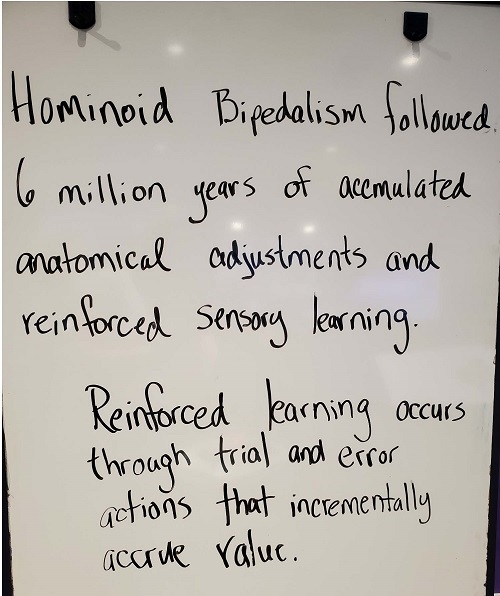Science is all about expanding the realm of human perception and human sense. Life is both. This tertiary course allows me to discuss how a change in perception and sense of the visuo-spatial cortex, hemi-chest compression, upper extremity reciprocation and lower extremity alternation of mass management can influence dominance or patterned design outcomes. A change in perception related to any one of these components, changes perception associated with the other three. This predominant component patterning, precedes our cortical and associated physical, physiologic and psychologic dominance in moving ourselves forward. I asked two individuals who attended this course to provide some honest, visceral feedback about the material that relates to the assessment and treatment of functional cortical dominance. Thank you Andrew Hauser ATC, CSCS, RSCC, PRT and Robert George DC, PRC for the following insights.

"I feel like I could write quite a bit about this subject as everything I felt like I learned in Vision& conversations from both you (Ron) & Heidi all came flooding back, and then some. It integrated all of it, and I appreciated how good of a job you did regarding bringing up what was backed by research. Simple, complex and everything in between. It’s tertiary for a reason, there is no doubt, but it felt like I could finally share what I had learned from you that others hadn’t yet experienced. It put it into words. I’m sure each course will be different, yet the golden thread will remain.
Where to begin?! The FLM course brought concepts from the previous vision courses, advanced integration and the primary courses and truly integrated them into what is driving the show on a daily basis. Being able to take all the phases of gait and break them down through our visual processes, hemi-chest airflow, upward limb alternation and how the lower half is responding & supporting these components of forward locomotor movement was a revelation. Understanding the biased-cortical / hemispheric "need for speed" and our abilities, as practitioners, to slow everything down may have turned this into a course on psychology, that wasn’t a course on psychology. I think they just took the lid off of Pandora’s box." – Andrew Hauser
"Last weekend Ron presented FLM and for this faculty member it was an experience that opened the door wider to PRI tertiary principles. Integrating Hruska hemispheric components of vision, hemi-chest wall airflow and upper limb alternation first, then considering lower limb alternation, really cemented the basics of forward locomotor movement. The course also opened the door to more questions for me especially when Ron was talking about the “trombone” effect of near and far vision for FLM.
I called Ron after this course today with not only questions but a realization that this last weekend so many light bulbs went on in my head that opened a gateway to somatosensory topics. I must confess when I took the vision course several years ago, I didn’t understand much after words! I was just learning to teach the basic mechanics of primary course work and was overwhelmed by what seemed to be a really complex subject. After this past weekend, not only did the vision course make more sense, but tertiary course concepts from Cranial Resolution and Occlusal Cervical Restoration became more clear as the sensory and motor components of coordinated and balanced movement were revealed.
One of my questions for Ron was regarding Functional Cortical Dominance. In our talk today, Ron was discriminating between cortical dominance as well as individual pre-dominance developed over time. In Postural Respiration, we present the very basics of the left half of brain contributing to right sided dominance. But the discussion is much more complex including what we see, hear, feel, sense from the ground, temperature, where sound is coming from and the visual kinesthetic sense of movement and flow of things going past us. This is a short list of sensory input in addition to a psychological component of how we respond to the mystery of being alive for a sense of well being!
In a recent walk I had in nature with Ron and Robin, the topic of discussion was the very human hunger and need of having a sensual experience in nature for our mental and emotional wellbeing. Filling our senses the sight of waterfalls, rivers flowing into pristine lakes, seeing the varieties of color, wildlife and trees all fill a need for a sensual experience. Ancient natural sound that we have heard as humans for thousands of years like the sound of wind in tall trees, flowing water falls, a thunderstorm and the sound of wildlife including birds and a coyote call are all in our DNA. The mille-second processing of natural sounds orient us in time and space and even feeling the wind on one side of our face gives us a sense of direction and orientation as well. Becoming conscious of and feeding all of our senses we all hunger for but have become unconscious or disconnected from in a converged modern world. These somatosensory experiences expand our awareness, feed our mind and emotions beauty and inspiration and allow for the joy and freedom of movement that is rare in a paved over, domesticated and confined modern experience we just assume is “life”.
Sensory processing though our five senses is a complex, multilayered experience affecting all parts of our brain all at once with horizontal and vertical movement, flow and forward motion and a mental and emotional response that is processed unconsciously and consciously instantaneously.
Ron asked be for a brief recap of my brief discussion today and as I see it as movement specialists in PRI, expanding and becoming more conscious of our own sensual acuity with the purpose of understanding not just human movement, but providing a path to more sensory awareness, internal mental and emotional fulfillment and well being for our patients and ourselves is a worthy endeavor." – Skip George


